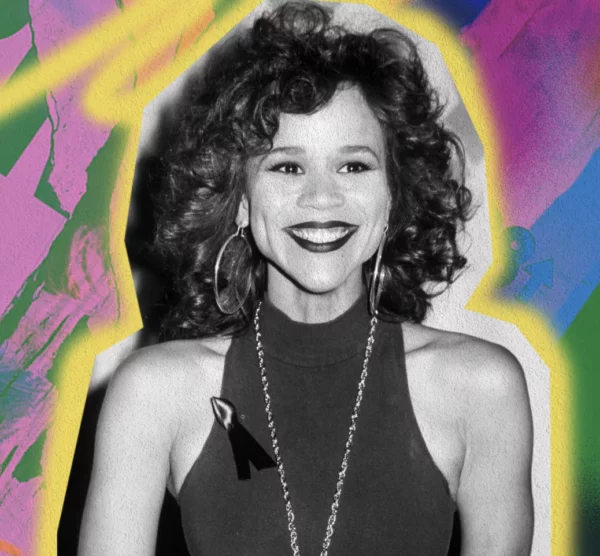By Janel Martinez, POPSUGAR
When Billy Hoyle — a white basketball player with a sick jump shot in 1992’s “White Men Can’t Jump” — gets hustled by his teammate Sidney Deane, Billy’s girlfriend springs into action. Heading straight to Sidney’s house, Gloria, played by Rosie Perez, makes an agreement with Sidney’s wife, Rhonda. As the two women block the TV to announce the terms of their deal, one of the guys yells for someone to tell them to move.
Sidney responds, “Why don’t you tell them to move? Them Black women over there, you think I’m crazy?”
The Puerto Rican actress, dancer, and choreographer is one of the women referenced in the subtle-yet-affirming scene. While the words are likely to get lost in the film’s overall plot, it was an acknowledgement of Perez’s identity: a light-skinned Black woman. In her 2014 memoir, “Handbook for an Unpredictable Life: How I Survived Sister Renata And My Crazy Mother and Still Came Out Smiling (With Great Hair),” Perez shared that the role of Gloria was originally intended for an Italian or Irish American actor.
“It’s an important affirmation because it sends the message that, one: Black people are global; we come in various shades and exist all over the world,” journalist and TV/film critic Kathia Woods tells POPSUGAR of the scene. “Two: Latinos include people of various races and ethnicities, one of which is Black.”
For many Afro-Latinas, Perez’s earliest appearances on the silver screen marked an integral acknowledgment of their existence in the mainstream.
The Brooklyn-born performer caught the world’s attention in Spike Lee’s 1989 film “Do The Right Thing.” During the opening credits, Perez delivers an unforgettable dance sequence: pumping, kicking, hopping and spinning over Public Enemy’s “Fight The Power.” Her fierce expression and electrifying moves made cinematic history; she left a mark that many — especially Afro-Latinas — would never forget.
“It was the first time that I had seen someone that looked like me, people in my family, on screen moving their body in a way that we normally move when we dance, not in a way that we see in the media, on that big of a platform,” says Crystal Shaniece Roman, CEO and founder of The Black Latina Movement. “It was like, she’s one of us and she’s representing us.”
Throughout her now 30-plus year career, Perez has consistently been her authentic self, no matter the audition. In 1993, she appeared on the “Late Show with David Letterman” donning her soft curls, large hoops, low-cut ‘fits that accentuated her figure and, of course, her one-of-a-kind Nuyorican accent. Though she’s noted that she has enjoyed her interviews with Letterman, some portions are hard to watch as the former TV host teases the Afro-Boricua actress, pinpointing her outfit of choice and mannerisms like her “hard” laugh. Even under the spotlight of a coveted late-night TV appearance, she couldn’t escape being typecast.
Luckily, there was already a space where Perez’s demeanor was more familiar: Black television. She was frequenting the club scene when a talent scout for “Soul Train” invited her to dance on the groundbreaking show at 19. While balancing several jobs and studying biochemistry in Los Angeles, she became “Soul Train”‘s “It girl.” “Rosie came on the show, and she was just so hot and so sexy. That girl could dance. She could move,” said fellow “Soul Train” dancer Crystal McCarey in Nelson George’s book, “The Hippest Trip in America: Soul Train and the Evolution of Culture and Style.”
Melissa M. Valle, Ph.D., an assistant professor in the Sociology and Anthropology and African American and African Studies departments at Rutgers University-Newark, witnessed Perez on-screen in the ’90s. She recognizes how complicated a role the actress straddled in the public eye: the thin line between representation and pigeonholing was everpresent.
“[Rosie] embodies an experience, a human experience, and it’s a cultural experience that does need to be put out there,” says Valle. “But we also know this is where representation becomes a little bit complicated in that they want her to be that [one thing]. That’s what they came for. That’s what they’re entertained by.”
“Soul Train” furthered the star’s professional dance career. Perez choreographed the music videos for Bobby Brown’s “Don’t Be Cruel” and “My Prerogative” and later worked with the likes of Heavy D & The Boyz, Diana Ross, and LL Cool J. After she met Keenen Ivory Wayans at one of Eddie Murphy’s house parties (a story she tells in her book), Perez became the three-time Emmy-nominated choreographer for “In Living Color’s” Fly Girls. As she booked performers, curated the music, and choreographed eight routines per week, Perez discovered and advocated for new talent like Jennifer Lopez and Queen Latifah. The famed sketch-comedy show wasn’t the only venture that would lead to widespread recognition for her; the Dec 1993/Jan 1994 “Vibe” cover girl also earned an Oscar nomination for her performance in 1993’s “Fearless.”
By the 2000s, Perez’s impact would also be felt amongst her people as an activist for Puerto Rican rights; she was arrested in 2000 after protesting against US bomb ranges in Vieques. Her career would continue to blossom as well — she went on to star on Broadway and in a number of movies and TV shows, and cohosted the popular daytime program “The View.” Still today, Afro-Latinas are far from getting their just due. “I’ve seen change, but it’s not what it should be,” Perez said in a 2020 “New York Times” interview on Latinx representation in Hollywood.
Click here to read the full article on POPSUGAR.



